| 1 | Ball python |
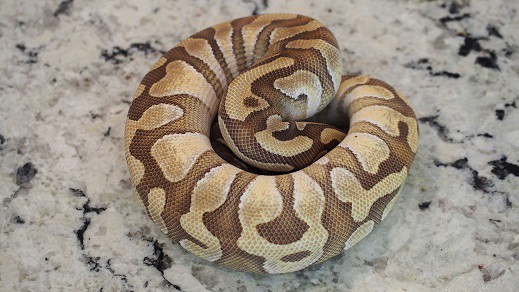
This is the most notorious brain shielder, one that reptile enthusiasts around the world regularly witness. Ball pythons live in western and central Africa, such as in Nigeria, where they live harmlessly in crop fields and hoover up rodents for adoring farmers.
Alongside corn snakes, they’re perhaps the most popular snake in the pet trade. 49,437 were exported from Togo only in 2005. Ball pythons are easy to feed with pinky mice and they rarely nip your fingers when feeling threatened. Instead, they shift their coils into a tight, protective ball. They go from being a tube to a perfect sphere. You only have to pick a ball python up in your hands for this ball to form.
At 1 metre, the ball python is one of the shortest pythons on Earth, with the African rock python reaching 6 metres. Nor do they have an insane, brutal personality. So a ball python’s best option is to coil up tight and protect its most important organ as effectively as possible. The ball python’s closest relative is Anchiete’s python in parched Namibia, which also forms a ball.
| 2 | Cross-marked grass snake |
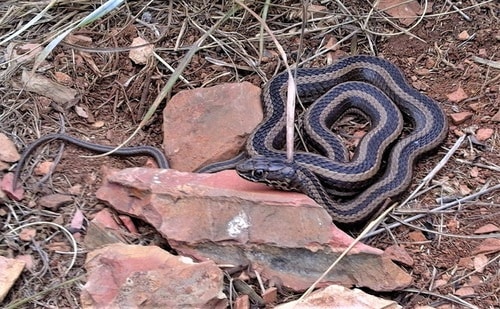
The cross-marked grass snake lives in South Africa and Zimbabwe and is part of the huge Psammophis family of snakes. This is like the African equivalent of garter snakes – they’re everywhere all the time, yet so harmless that nobody pays them any attention. The cross-marked grass snake measures 50cm and gets 90% of its calories from reptiles. They live in many habitats, including moist savannah, montane forests, sandy scrub and grassland.
Usually, the cross-marked grass snake gives no thought to shelter at all. It zooms around the African savannah, skirting along logs and searching eagerly for prey scents. But when a hungry bird approaches, they suddenly stop. They curl up into a tight web of coils with their head at the centre, the goal being to protect their brain, the most important part of their body.
If a bird’s talons rip savagely at its tail, it might damage their agility, but it won’t end their life. Birds have their own threats in the savannah, not least cackling hyenas. If the cross-marked grass snake can protect its brain until the bird gives up, then its life is saved.
| 3 | Indian wolf snake |
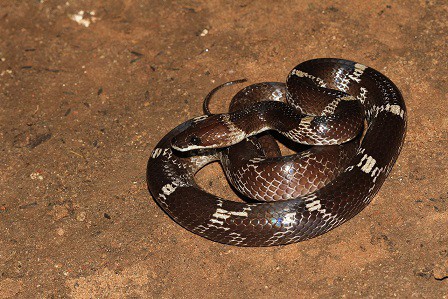
The Indian wolf snake is the species with a million defensive strategies. They lack venom, but the Indian wolf snake can play dead by flipping onto its back and gaping its mouth lifelessly. They have a vicious personality and fangs that can tear through human skin. They can also hiss or flee into bushy undergrowth. Shielding their brain in coils is another part of their repertoire. If a human or owl looms overhead, this 70-80cm species will rapidly rearrange its coils, forming tight loops which shield its head from attack and potential obliteration.
The plan is to survive the encounter wounded yet alive. Indian wolf snakes invade human dwellings, yet get very defensive when they meet humans in them. This snake is extremely common, inhabiting virtually all of India (excluding deserts and the Himalaya).
Predicting an Indian wolf snake’s next move is virtually impossible. Hiss, play dead, shield their brain in coils – which will it be? It’s possible that they’ve evolved to fit different predators. Humans are all the same, but different coloured clothes could set them off. They might be more willing to fight in high temperatures or humidity.
| 4 | Mud snake |
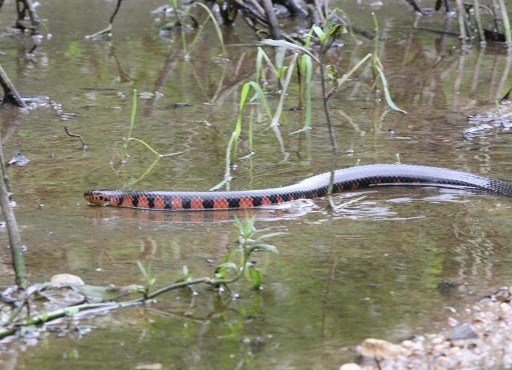
The mud snake is the gentle giant of Florida’s swamps. This is a snake which reaches 2 metres, but doesn’t realise that it can use its size to its advantage, or is simply kind-hearted and doesn’t want to.
At a distance, the mud snake’s instinct is to go completely still and let the predator walk past. This leads to the eerie sight of a mud snake floating motionless on a swamp, bathed in the moonlight. If a hungry heron closes in, then the mud snake will coil into a tight ball with its head at the centre. The mud snake is a thick-bodied serpent as well, being a constrictor (preying almost exclusively on amphibians). Therefore they have lots of material to shield themselves with.
Living in remote swamps, mud snakes aren’t seen often by the average Floridian. Yet surveys show that they’re common, so their non-offensive strategies must be paying off. Mud snakes also live in Georgia and Alabama and can bury themselves metres deep in soft mud along swamp edges. In times of heavy rains, they can move several hundred metres onto land in exploratory expeditions.
| 5 | Common slug eater |
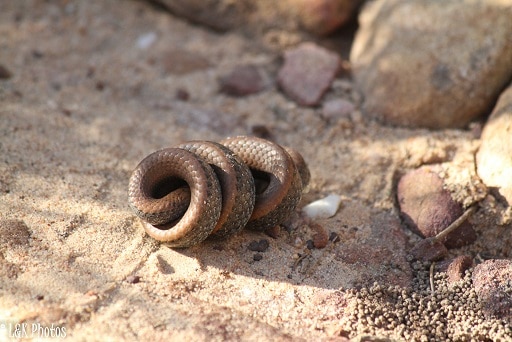
To slugs, Duberria lutrix is the most terrifying creature in the world. To everyone else, it’s a small, humble creature which is just trying to get by. Common slug eaters measure just 30cm and inhabit southeastern areas of South Africa, particularly damp regions where slugs prosper. Compared to a cape cobra, this species has nothing. They have no venom, they’re not fast, and they almost never bite. What they do have is determination, to survive no matter what the African savannah throws at them.
If approached by a human, they’ll first release a foul-smelling substance, to force its enemy to leave the vicinity. If touched, then they’ll suddenly roll up into a tight spiral with their head concealed at the centre. This species has the Afrikaans name of Tabakrolletjie (tobacco roll) after their brain-concealing ways.
Duberria lutrix will gladly bear savage scars for the rest of its life as long as it can survive and continue its quest for slugs. This snake is the most common member of the 4-strong Duberria (slug eater) family.
| 6 | Mountain slug snake |
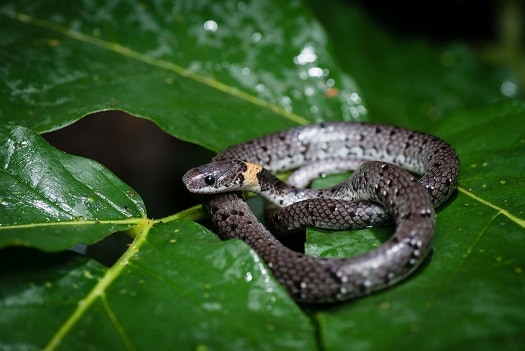
Part of a completely unrelated slug snake family native to southeast Asia. The white-spotted slug snake (Pareas margaritophorus) also dines on snails, sucking them from their shells by sawing an unevenly shaped jaw back and forth. They live at up to 1500 metres in Thailand and Cambodia, in humid premontane forests where they spend their days on low tree branches.
White-spotted slug snakes have stony grey colours contrasting against a white neck collar. Their camouflage is decent, but they lack any real defence. They lack venom, and they lack the aggressive killer instinct. Instead, they coil their lower body and drop their head down, to make it inaccessible for claws or talons. This includes a human wielding a camera. Being a forest dweller, white-spotted slug snakes have a nice predator shield due to the thick vegetation.
One wildcard we don’t know about is skull thickness. For example, scientists dissecting a Shaw’s sea snake in 2005 found that its brain cap was so thick they could barely reach the tissue inside. It’s possible that other snakes have unusually thick skulls, for defence against savage claws – maybe the white-spotted slug snake.
| 7 | Scarlet snake |
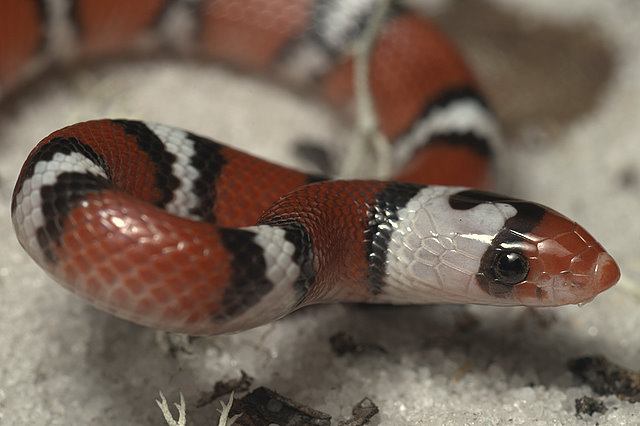
The scarlet snake is one of the hardest southeast US snakes to find. They live in coniferous forests and sparse flatwoods, sometimes next to rocks, but are nocturnal and spend a large chunk of their time underground. If you do meet one after 6000 hours of searching, then you may have wasted the whole year, but at least you won’t be bitten: the scarlet snake’s default is to coil up tightly in its coils to protect its brain. They rarely bite, even if prodded and poked.
Compared to some, the scarlet snake is more advanced. While shielding their brain, they simultaneously raise the tail to capture a predator’s attention. With their unchanging black-red-white, it makes it easier to confuse the two. Scarlet snakes also release a foul-smelling musky odour. Even if a racoon was determined to unwind the coils, it would be forced to leave the vicinity.
Scarlet snakes are non-venomous and primarily prey on turtle eggs, which has forced them to grow disproportionately brutal front teeth, for hacking through egg shells. Somehow, it hasn’t occurred to them to use these offensively.
| 8 | Ring-necked snake |
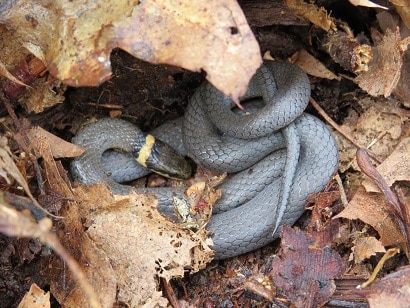
The ring-necked snake is one of the USA’s most humble. They measure just 30cm and live in forests, often hiding in the safety of anthills. It’s possible to find dozens of ringneck snakes in an hour, as they regularly congregate under logs, rotting bark, or manmade objects like sheet metal. This gives them natural safety, yet racoons and red-tailed hawks are canny creatures and can easily tear away these shields. So ring-necked snakes have one last shield to hide beneath: their own coils. They have the ability to coil up, place their head directly at the centre, and thus protect their brain from harm. They may form this brain shield while in the palm of your hand.
Ringneck snakes eat ants, earthworms, and small salamanders, while their own predators include broad-winged hawks and copperheads. They have at least 9 subspecies, the ringneck being the key ID feature. In the Florida keys subspecies, the ring is very faint, barely visible.
Ring-necked snakes aren’t complete pushovers, and will bend their heads back and bite savagely. The sweet (or sour) spot is the neck – touch and they’ll bite without fail. Ring neck snakes occupy virtually the entire US southeast.
| 9 | False smooth snake |
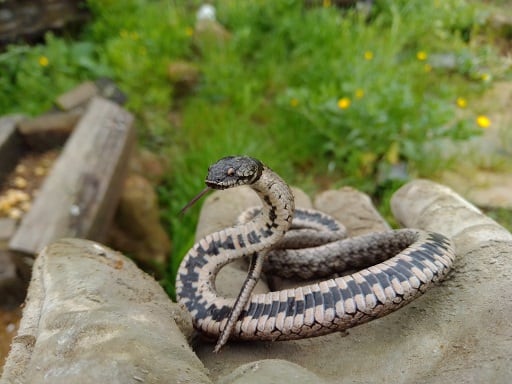
The false smooth is a shy snake of Spain, which isn’t seen often by locals. While the ladder snake spends its time zooming down sunny dirt roads and villages, the false smooth snake saw a niche in the soil and took it. This is a semi-fossorial snake which spends 50% of its time underground.
False smooth snakes possess a weak venom, but this is geared towards small prey (mainly reptiles). Instead, they tuck their head into tight coils and try bravely to withstand the onslaught. If a claw strikes their tail they’ll probably live, if a claw strikes their torso they might die, if a claw strikes their brain, they’ll definitely die. False smooth snakes may also bite – it’s hard to predict their next moves.
Fortunately, false smooth snakes don’t need this trick too often. A study on the short-tailed eagle, Spain’s most menacing bird predator of snakes, found that montpellier snakes and ladder snakes were easily their favourite. False smooth snakes were barely hunted at all, despite being abundant in the region studied (northern Portugal). Their underground, sheltered ways are enough to keep them safe.
| 10 | Desert rosy boa |
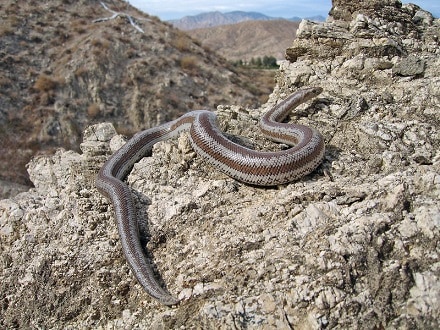
This harmless snake lives in rock cracks in the Arizona desert, also in northern Mexico. They spend much of their life in these cool cracks, poking their head out to check if mammals are approaching. Occasionally, they slither out onto the warm rocks and admire the sunny desert that they have all to themselves. But suddenly, a shadow falls on their back. The light is blocked out and a greedy falcon is about to assault them. It’s time for the desert rosy boa to bring out its long dormant defensive skills, and with no venom, its default is to protect its head in its coils.
Desert rosy boas measure 60-100cm and could fight if inclined, with many rows of sharp teeth, but have a docile personality. This makes them popular in captivity, and most keepers eventually witness their brain-shielding coils. The desert rosy boa preys on mammals such as kangaroo rats and rabbits, and prowls rocky deserts and semi-arid areas. Their closest relative is the coastal rosy boa, which inhabits San Diego County in California.
